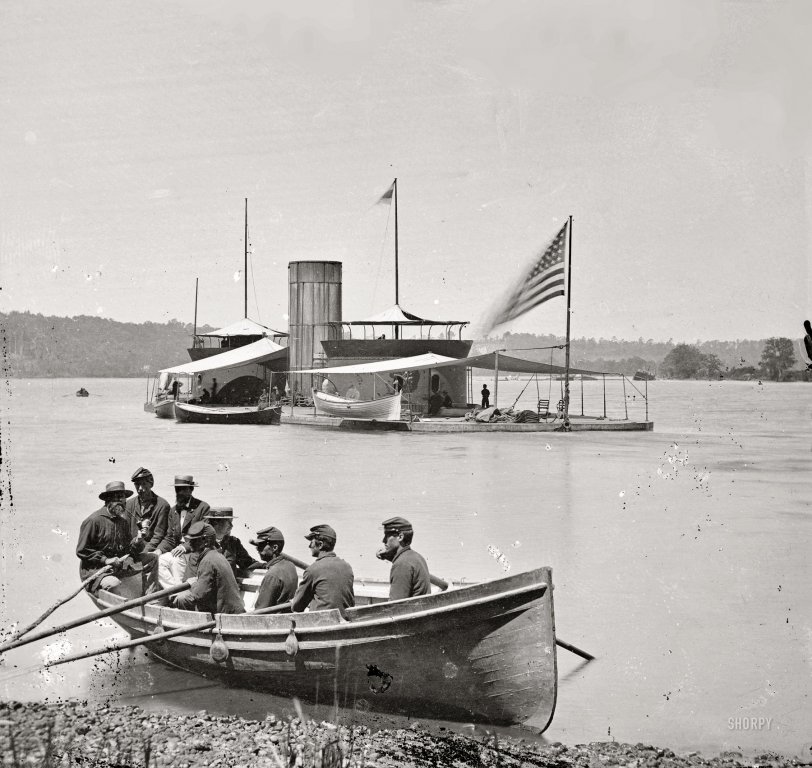


Framed or unframed, desk size to sofa size, printed by us in Arizona and Alabama since 2007. Explore now.
Shorpy is funded by you. Patreon contributors get an ad-free experience.
Learn more.

- Baldwin 62303
- Baldwin VO-1000
- Cold
- No expense spared
- Tough Guys
- Lost in Toyland
- And without gloves
- If I were a blindfolded time traveler
- Smoke Consumer Also Cooks
- Oh that stove!
- Possibly still there?
- What?!?
- $100 Reward
- Freeze Frame
- Texas Flyer wanted
- Just a Year Too Soon
- WWII -- Replacing men with women at the railroad crossing.
- Yes, Icing
- You kids drive me nuts!
- NOT An Easy Job
- I wonder
- Just add window boxes
- Icing Platform?
- Indiana Harbor Belt abides
- Freezing haze
- Corrections (for those who care)
- C&NW at Nelson
- Fallen Flags
- A dangerous job made worse
- Water Stop
Print Emporium
U.S.S. Onondaga: 1864

1864. "James River, Virginia. Monitor U.S.S. Onondaga; soldiers in rowboat. From photographs of the Federal Navy, and seaborne expeditions against the Atlantic Coast of the Confederacy." Wet plate glass negative. View full size.
Boat Fenders
The small round objects hanging over the side are boat fenders, used to prevent damage to the rails when the boat is moored alongside something like a dock or the Onondaga. These are probably made of leather, and if they contain anything, it's probably more leather padding or perhaps a disk of soft wood.
Ride So Low
Monitors were river craft essentially floating gun platforms. They are not ships in the normal sense. Their freeboard (distance between the main deck and water line) was very small so they would present less of a target to opposition fire. Heavily armored above the main deck, they could withstand direct hits from the guns of the day without serious injury.
Bumpers
Those, probably leather, bags over the rowboat's side are fenders/bumpers meant to protect the sides of ships when docking. Today we use plastic fenders which are plastic and much larger (shaped like a serious hot dog).
Buffers-low in the water
Monitors were built very low in the water in order to present as little as possible of a target to an enemy gunner. They were very useful in inland waterways, on the open seas, in any bad weather, they would be in serious danger.
My guess on the three bags on the launch is they are buffers to keep the wood of the boat's side from getting banged up when it is up against a wharf or another vessel in wavy water
historical ship
I looked the Ol' Onondaga up and she had quite a history. She was built in New York and sent to Virginia where she saw several important engagements. She was decommissioned in 1865 and sold to the French navy and refitted with rifled cannons of just over 9 inch. Replacing the 8 in smooth bore guns of American vintage. She was scrapped in 1902. Pretty impressive!
How Low Can You Go?
Not a lot of freeboard on the good ship Onondaga.
[The Onondaga was, as noted in the caption, a monitor or ironclad. - Dave]
Low in the water.
It would not take much to swamp this ship. Questions? Why were they built to ride so low? What is in those little bags tied next to the oars on the sides of the rowboat? I suspect the older man with the pipe at the stern using a rough stick is acting as a rudder. Interesting snapshot of life!
Appropriate Headgear
For once, someone's wearing a boater in a boat. . . .
























On Shorpy:
Today’s Top 5